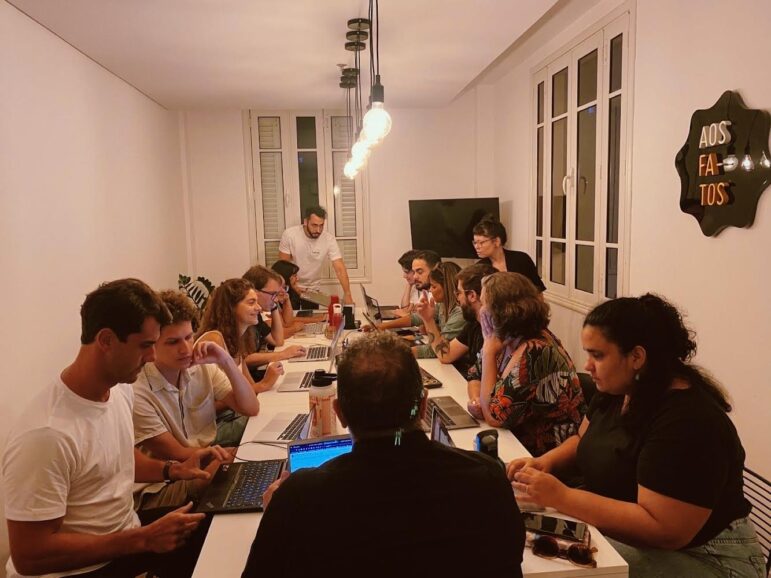
Tai Nalon (center) co-founded the Brazilian investigative and fact-checking site Aos Fatos in 2015. Photo: Courtesy of Nalon
For GIJN’s My Favorite Tools series, we spoke with Brazilian journalist Tai Nalon, executive director and co-founder of the fact-checking website Aos Fatos (“to the facts”). Aos Fatos was founded in 2015 by Nalon and her colleagues Rômulo Collopy and Carol Cavaleiro, and was inspired by the Argentinian site Chequeado, the Poynter Institute’s PolitiFact, and The Washington Post’s Fact Checker.
“I never imagined that I would have my own vehicle and that it would gain international relevance.” — Tai Nalon, Aos Fatos co-founder and executive directorThe idea for the platform arose from Nalon’s general dissatisfaction with the political coverage she had done at Folha de São Paulo, Brazil’s largest-circulation newspaper. At the time, she worked on verification initiatives that were carried out only during election periods — she thought there should be something similar on a permanent basis.
In addition to Folha, Nalon has worked for several outlets in Rio de Janeiro, Brasília, and São Paulo, such as Globo’s g1, Veja, and Piauí magazines, with a special focus on national politics, public policy, and transparency. In 2009, she was nominated for the Nuevo Periodismo Award. “When I look back and think about what brought me to journalism, I don’t know how to explain it, because I never imagined that I would have my own vehicle and that it would gain international relevance,” says Nalon.
Her idea of success in 2004, when she enrolled at Federal University of Rio de Janeiro (UFRJ), was quite different. “I wanted to work at Folha, and I actually worked at Folha, and I wanted to cover politics, and I did cover politics,” she explains. “But I also joined a big newsroom right around the time of the 2008 crisis, so I think I only experienced this slow process of downsizing and decline [of the big newspapers],” she adds.

Brazilian investigative journalist and fact-checker Tai Nalon. Photo: Courtesy of Nalon
“I don’t think it was very advisable to make a long-term bet on a newspaper,” she says. “Not that it would be very advisable to bet on a start-up, with the rest of the savings I received after I was fired, and a difficult crowdfunding strategy. It took a while to work out, and in fact, it almost didn’t.”
It took three years for Aos Fatos to reach a stable income, Nalon says. “But that was in another context,” she notes. “Declaratory journalism [which uncritically reproduces the statements of official sources] was already a problem, but we didn’t have habitual liars in governments.” In her view, it was only after the rise of Trump in the US and Bolsonaro in Brazil that fact-checking started to gain importance beyond journalism, a development that contributed to the site’s growth.
The other reason for Aos Fatos’ success, she believes, is their investment in technology and innovation projects, such as their own tools and services. Nalon now leads an award-winning team of more than 20 people.
We asked Nalon about the tools and techniques she uses the most for fact-checking. These include the stalwart TinEye and Wayback Machine and, of course, the tools Aos Fatos has produced, but she also lists some simple ones that are accessible to anyone who wants to get started in fact-checking. Here are some of her favorite tools.
Radar Aos Fatos
Aos Fatos’ Radar is a real-time disinformation monitor tailored to Portuguese-language media. Its algorithm maps multiple platforms, looking for keywords and linguistic patterns common to disinformation campaigns, helping reporters map in real time what is going viral in specific topics, such as coup attacks or COVID-19 and vaccines. It can also identify whether the same false narratives are spreading across multiple networks and apps, and how they interconnect.
“Radar must undergo improvements in its usability,” she says, “but its public face manages to show in a very complete way the messages with high chances of misinformation that circulate on platforms such as WhatsApp, Twitter, Facebook, Instagram and YouTube.”
Also developed by Aos Fatos, Escriba is a tool that automatically transcribes large audio and video files in Portuguese, English, and Spanish.Radar is open to partnerships for investigations, such as the recent collaboration between GIJN member Agência Pública and Núcleo Jornalismo during the 2022 Brazilian elections, or the survey carried out for The Washington Post for a report on electoral disinformation in Brazil. If you are a journalist or researcher, you can also contact the Aos Fatos team and request databases through radar@aosfatos.org. Aos Fatos operates a “freemium” service — it’s free to use for some sectors, and has a paid version for others.
Fátima
Currently available for free on WhatsApp and Telegram, Fátima — derived from “FactMa,” an abbreviation of “FactMachine” — allows readers to check whether certain online information is false, and to find the corresponding verification. If there is no match, it delivers other options within the queried topic, or the user can search for a new keyword. “It’s a powerful crowdsourcing tool for the newsroom, because, based on user requests for checks, we are able to find out what is going viral within these applications, whose communication is not open,” says Nalon. (Both WhatsApp and Telegram are encrypted — but based on what users are asking Fátima, it’s possible to find out what topics and potential disinformation are trending on those platforms.)
The Telegram version was developed for the 2022 Brazilian elections, in partnership with the Votorantim Institute. “Today we focus on perfecting Fátima’s responses to user queries and improving crowdsourcing integrated into our own content management system,” Nalon explains.
Escriba
Also developed by Aos Fatos, Escriba is a tool that automatically transcribes large audio and video files in Portuguese, English, and Spanish — though the interface is in Portuguese — which can be used for interviews as well as media circulating on WhatsApp and YouTube.
“We initially developed Escriba based on an internal demand for a tool that would help us monitor, for example, the various public appearances of former President Jair Bolsonaro,” says Nalon. One advantage, in her view, is that Escriba was developed for Brazilian Portuguese — something rarely found on the market.
The service has a monthly fee of R$50 (around US$10), with subscriptions available to individuals and companies. The fees finance Aos Fatos’ journalism.
BuiltWith and Who.Is
Nalon uses these tech tools — which have similar functions — to find domain owners, their addresses, and IPs as a starting point for investigations. To check information about a domain using Who.Is, you just need to insert the relevant URL to retrieve the information associated with that URL’s domain. “The tool does a scan and brings back information, if available, about who owns the site in question, if they own other sites, if there is sharing of AdSense codes and other programmatic advertising tools,” Nalon explains. (For more on using the Who.Is database and investigating the origins of websites, check out GIJN’s chapter on digital infrastructure in our Reporting Guide on Digital Threats.)
The tools have already helped Aos Fatos to identify owners of websites that publish disinformation, which monetization tools they use, and whether more than one website uses the same monetization tool, which she explains may indicate that publications are coordinating to create propaganda campaigns.
Comparing the two tools, BuiltWith has some extra — paid — features. But Nalon says the tools complement each other: “Sometimes it’s good to know that both exist, because if one sometimes doesn’t deliver up-to-date data on website domain owners, it may be that the other does.”
“If a site has a large audience, uses programmatic advertising tools of various kinds, and publishes disinformation, it is certainly making money by deceiving others.” — Tai Nalon, Aos Fatos co-founder and executive directorSimilarWeb
SimilarWeb is a tool used to measure a website’s audience, and makes it possible to see the access history — such as who has accessed it and how many views it has — of sites that publish misinformation. “The data is not very precise, but it gives an idea of the volume of people who are impacted by articles, which are often misleading, on certain sites,” says Nalon.
This can be a good starting point for understanding the interests behind certain disinformation: “If a site has a large audience, uses programmatic advertising tools of various kinds, and publishes disinformation, it is certainly making money by deceiving others.”
LAI (Brazilian Access to Information Law)

Tai Nalon (standing, top right) now leads a team of more than 20 people at Aos Fatos. Photo: Courtesy of Nalon
For Nalon, the Access to Information Law (LAI), Brazil’s equivalent to FOIA, is a powerful tool for investigating government spending on advertising and, ultimately, on misinformation. “If the government is truly transparent, it will account for its ads on websites and social networks — how much it spends, where it centralizes spending, which companies were hired to manage the communication of certain campaigns,” she explains. All of these details can form the basis of a good story idea, Nalon adds.
She points out a potential way to use this law to investigate public policy misinformation: “A politician says he did something. Then you ask for the execution of a certain contract via LAI, which shows something else. That way you can prove that the politician was not telling the truth.”
It’s important that journalists make use of what is guaranteed them by law, and to persevere in the face of ill will, or attempts to hide the truth disguised as bureaucratic excuses. “By knowing what and how to ask government bodies, it [makes it] possible to understand what decisions are taken and how public policies are defined,” she adds.
Additional Resources
My Favorite Tools: Geo-Journalist Gustavo Faleiros
My Favorite Tools: How Rafael Soares Investigates Police Killings in Rio
Brazil: 5 Questions for a Reporter Investigating Bolsonaro’s Scandals
 Ana Beatriz Assam is GIJN’s Portuguese editor and a Brazilian freelance journalist. She holds a BA in Social Communications: Journalism from São Paulo State University and was a trainee at the 28th Journalism Course of the newspaper O Estado de São Paulo. She worked for the newspaper as a freelancer covering a range of subjects, mainly with data journalism in the Politics section.
Ana Beatriz Assam is GIJN’s Portuguese editor and a Brazilian freelance journalist. She holds a BA in Social Communications: Journalism from São Paulo State University and was a trainee at the 28th Journalism Course of the newspaper O Estado de São Paulo. She worked for the newspaper as a freelancer covering a range of subjects, mainly with data journalism in the Politics section.
The post How Tai Nalon Creates New Tools to Investigate and Fact-Check Brazilian Politics appeared first on Global Investigative Journalism Network.

 1 year ago
67
1 year ago
67
